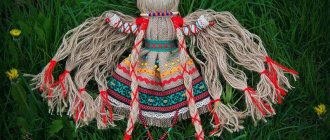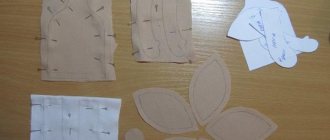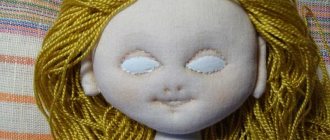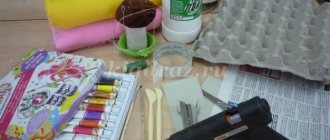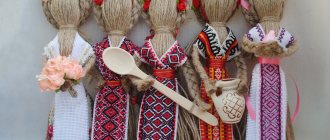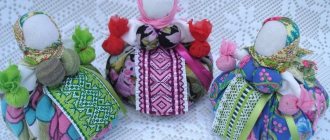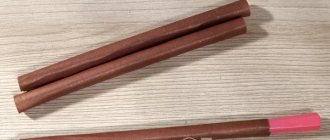Motanka doll among the Slavs and its history
Historians believe that motanki first appeared more than 5 thousand years ago. Their appearance is associated with the beginning of flax production. They were made for a whole family or for one person. Women, children, men, old people - all people received amulets from the hands of their relatives.
Dolls were placed in babies' cribs to protect them from the evil eye. Adults always carried the amulet with them, and travelers took it on the road, hoping that the doll would protect them from troubles and misfortunes.
Each doll had its own meaning. They were carefully stored and placed in the most visible place in houses. They were carefully looked after, cleaned of dust, and even passed on from generation to generation.
Motankas were made from available materials: vines, herbs, cereals, etc. The basis was linen fabric. With the advent of mass production at the beginning of the 20th century, dolls were no longer made with their own hands.
Today, many needlewomen remember ancient traditions and sew dolls on their own. Despite the fact that girls rarely put any meaning into dolls, motanki are still considered a powerful amulet that protects against the evil eye and damage.
Motanka is a powerful amulet that not only protects a person, but also helps solve any of his problems.
Twist doll manufacturing technology
The scheme for creating a magic toy is simple, but you will need sewing skills.
The simplest master class on how to make your own amulet:
- Take a square of fabric and fold the edges inward.
- Place cotton wool in the middle and twist tightly.
- Tighten with thread at the neck and waist.
- Place a twist and a piece of cotton wool for the head on the second flap.
- Bandage around the neck.
- Straighten the fabric, remove wrinkles from the face.
- Measure the material into your hands, form your palms.
- Fix the free corners around the body.
Female version
For amulets girls, the best solution would be a traditional sundress.
You can do it like this:
- Place 2 narrow colored stripes in a cross on the chest and back.
- Tie it at the waist.
- Fold the square of fabric in half and tie it to the figurine.
- Tie a scarf, put on a belt.
Male version
For a boy's amulet, they choose a shirt, pants, a hat, and to make the doll look brighter, hair is made from threads.
Advice on how to dress up a doll:
- Make a cut in the shirt flap and trim it with braid.
- Measure fabric for pants.
- Sew the edges along the width.
- Fasten the sleeves to the wrists, and the bottom to the hips, wrapping them with thread.
- For the hat, sew a rectangular piece into a tube, gather and secure.
Types of motanka dolls and their meaning
The concept of “motanka” comes from the word “to wind”. The fact is that the reel was made from threads in a special way. For production, rope or fabric threads were used.
All pupae are divided into several types:
- Game toys were made for children and were purely entertaining. The appearance of the dolls could be presented in the form of a person or an animal.
- The amulets are a knotted doll made in the shape of a cross. Such a doll should not look like a person, so it did not have a face.
- Ritual - crafted in honor of a holiday. Most often, motanka was given for the birth of a child, Maslenitsa and Easter.
Each doll was dressed up using 3 pieces of clothing: a skirt, a long-sleeved shirt and a scarf. The headdress symbolized the connection with the sky, and the skirt - the earth.
Joy Bird
Joy Bird
- a ritual doll that was used to attract Spring. In order for Spring to come, at the beginning of March, married women, who were the main characters in the ritual, and young girls put on bright clothes and went beyond the edge of the village to call for spring. They wore hats in the shape of birds, decorated with fur trims and feathers, that is, the women themselves appeared in the form of birds, because they believed that Spring flies on the wings of a bird.
There was even such a sign - if a bird lands on a woman’s head, hand or shoulder, then she will be blessed with good luck and happiness all year long.
Author - Anastasia Bobrovnikova
This doll makes a woman feel her purpose and attractiveness. It is made using birch logs.
Author - Anastasia Bobrovnikova
Tatyana Bereznaya shows a master class on making a motanka doll “Bird of Joy”:
https://www.youtube.com/watch?v=suetn5mfr9Q
Varieties of reels
Rag dolls were created according to ancient patterns, but each craftswoman put something of her own into the amulet. In Rus' there were a great many motanka dolls. Each variety had its own meaning and had unique magical properties.
Zolnaya
The ash doll is an ancient amulet for the home. Its main role is to protect housing from evil forces, attract wealth and family well-being.
Bereginya was made when moving to a new home in order to take a piece of the family’s strength to a new place. Also, the doll was passed down through the female line from mother to daughter. When a girl got married and moved in with her husband, she took the ash doll with her.
The ash bereginya was always made without hair and headdress. The amulet was based on a ball rolled from sifted ash and water. The ball was wrapped in a piece of white fabric, cut from a worn dress. The torso and arms were formed using fabric. The head was also twisted from ash. To make the doll stable, it was fixed to a branch with three branches.
An ash doll is a symbol of family hearth and prosperity
Herbalist eggplant
The herbalist is a doll that combines such elements of Slavic culture as healing and needlework. Bereginya was made from fabric, stuffed with various herbs. The meaning of the doll was determined by what herbs were placed in it.
Traditionally, the Herbalist was a family amulet that helped heal sick people and ward off illnesses from healthy people. The doll was often given to children so that they would always remain active and cheerful.
Most often, the Slavs placed the stems, flowers and roots of one plant in a talisman. Thyme was used to combat insomnia, and mint was used to relax.
Herbalist - a doll that expels evil spirits and heals sick people
Pelenashka
In ancient times, they tried to protect pregnant women and babies from diseases and troubles. For this purpose, craftswomen were engaged in making Pelenashki dolls. They were made a couple of months before the birth, and then “given” to the newborn.
The Slavs believed that a baby is most vulnerable to evil forces. That is why Pelenashka was placed in the cradle of a baby up to 2-3 years old. With the advent of Christianity, the amulet lost its power. It was believed that after baptism the baby was protected by a cross.
When a newly-made wife moved into her husband's house, she was also presented with a doll. The diaper was placed on the girl’s lap so that a child would appear in the family as soon as possible. For the same purpose, older women sewed dolls for girls having problems conceiving.
Pelenashka's appearance was the personification of a person. The amulet resembled a baby wrapped in a swaddle.
The Pelenashka amulet was intended for pregnant women and newborn children
Lovebirds
The Slavic amulet Lovebirds is a symbol of family unity. The amulet helped the newlyweds maintain close relationships, and also protected their home from negative energy, attracting only wealth and prosperity.
The amulet consisted of two figures - a girl and a guy, connected by a common hand. A paired doll was given to the bride and groom for their wedding. When the lovers had a baby, string baby dolls were attached to the common hand. The more children there were, the stronger the family became. The power of the amulet extended to every newborn.
The Lovebirds amulet helped newlyweds conceive a child, and also brought prosperity and happiness to life
Desire
The Zhelannitsa doll is a talisman that was a source of energy power. Motanka was able to destroy all obstacles in front of her on the path to the fulfillment of her desire. Craftswomen made the doll using ancient technology, trying to “breathe” life into its image.
The amulet could belong either to its owner or to the entire family. It was believed that the image of the motanka repeats the appearance of the Goddess Doli. However, they turned to her for help only as a last resort. People believed that the Goddess should not be disturbed over trifles, since she is responsible for fateful changes in a person’s life.
People believed that the doll would hear the request only after the person made it with his own hands, gradually creating the image. While working, you need to be in a peaceful state, turning over your desire in your head.
The Desire's face was decorated with a cross made of bright ribbon. For the motanka, they sewed several more outfits so that during dressing they would have more contact with the amulet.
The wisher helped a man fulfill his most cherished dream
Purifier
The purifier is a strong home amulet that is responsible for the cleanliness of the house. The doll was based on a broom, which protected the home from negative energy. If the residents felt irritable, they made a similar amulet.
In addition, the purifier was made for children suffering from insomnia and incontinence. The mother swept the child with a decorative doll after a walk to neutralize someone else’s negativity. The amulet was also placed under the pillow for children, and during illness they applied it to the sore spot.
The purifier was made in order to cleanse the house of bad energy
Ten-handle
A ten-handle is a reel that was intended for its own craftswoman. The doll was given 10 threads so that the owner could keep up with all her tasks.
While working, the girl made a wish for each hand, believing that the amulet would help fulfill them. Traditionally, the doll was made from bast or straw. The main attribute of Ten Handles was a long braid decorated with bows.
For a long time, after production, the doll was immediately burned. But at one point, people abandoned this tradition and began to install the doll in the most prominent place in the house.
Ten pens were often given to women so that they could do all their household chores.
Day Night
The “Day and Night” amulet was made in order to protect one’s life from the thoughts of others. The Slavs created two dolls of equal strength, but with different appearances. The first reel was black, and the second was white. Both dolls were connected with one thread, showing that the talisman protects a person both day and night.
It was believed that the bright doll drove away envious people and evil spirits from the house throughout the day. The Black Bereginya protects the sleep of all family members, driving away terrible dreams.
Sometimes the Slavs made a two-faced “Day and Night” doll. To do this, they made a reel, one side of which was white and the other black. Every day, depending on the time of day, the amulet was turned over to the desired side. It was believed that if this was not done in time, then problems would begin in the lives of all residents.
The “Day and Night” doll protected the house during the daytime, and at night protected the sleep of the residents
bbw
The Fatty doll is a talisman against female loneliness. The talisman was made by women who dreamed of having a baby.
If a girl did not become pregnant within a year after marriage, her mother or mother-in-law made a motanka and hung it at the entrance to the house. By giving such a gift, women who gave birth passed on their ability to bear children to the young woman.
After pregnancy, the doll was removed and hung in the room of the young mother. During pregnancy and childbirth, the amulet was hidden from prying eyes, but always carried with them.
The Fatty amulet was intended for girls who could not get pregnant
plantain
The plantain is a doll that protects people from various troubles while traveling. They took the talisman with them on the road in order to return home safe and sound.
The motanka was made small and worn in the bosom or pocket. Bereginya could not be shown to strangers, otherwise her magical properties would disappear.
To make the amulet, a plain, dim fabric was used. A small bag was sewn into the doll's hands, into which a handful of native soil was poured. Over time, they began to put wheat grains there so that people would not go hungry on the road.
Most often, such a talisman was intended for men. It was not allowed to make a doll yourself. Bereginya was made by the guy’s wife or mother. Only the craftswoman and the owner could touch the amulet.
The plantain was a male talisman that protected a person from troubles on the road
Veduchka
Veduchka dolls appeared so long ago that it has not yet been possible to establish the period of their origin. It is believed that in those days family values were placed above all else. Women took care of everyday life, raised children, and men provided for the family. It was then that the wives came up with an amulet for themselves that would help them cope with everyday life.
Veduchka is a paired doll representing a mother and her baby. The meaning of the amulet is that any woman always guides her child through life, telling him where to go.
Slavic women made motankas on their own, but the dolls were not only their helpers. Beregini protected children from the evil eye and diseases. A rag talisman helped maintain good relationships between children and brought order and calm to the house.
Veduchka is a doll symbolizing a woman and a child.
Krupenichka and the rich man
The doll Krupenichka and Bogach is a talisman for married couples. Home talismans bring material wealth to the house and also help increase savings. In addition, the amulet helps maintain warm relationships in the family.
Krupenichka and Bogach were filled with grain as a sign that there would always be prosperity in the family. Buckwheat was placed in the women's motanka, and oats were placed in the men's motanka. To prevent an evil spirit from entering the paired talisman, the doll's faces were left empty.
Over time, Krupenichka turned into a Zernushka doll, which was filled with completely different cereals. It often served as a ritual item during spring sowing. First, grain from the doll was thrown into the ground, and at the end of sowing, it was filled again. A similar ritual was performed to obtain a rich harvest.
Krupenichka and Bogach - a family amulet, personifying wealth and prosperity
Spiridon solstice
The doll Spiridon Solstice appeared during the times of paganism in Rus'. The name of the amulet comes from the Solstice holiday, which was celebrated in honor of the winter solstice.
The Slavs worshiped the sun, so they tried to protect themselves from evil in the dark. In this matter they were helped by Spiridon, holding a wheel in his hands. The pagans believed that with the help of this wheel the doll rotates the sun so that it shines for people even at night.
It is believed that the image of Spiridon was copied from the God Svarog. It was Svarog who always followed the seasons, turning the sun from winter to summer and from summer to winter.
Spiridon Solstice - a doll that served as both a talisman and a holiday attribute
Successful
The Successful doll is intended for a person who always fulfills his plans with high quality and on time. The main attribute of the doll is a bag slung over her shoulder with a coin inside. By its appearance, the motanka shows that it will help the owner with his affairs, but will not take on too much.
The talisman has always been created by the hands of a woman who would like to have support in routine matters. The Slavs believed that the Successful Woman would help a person in any endeavor, regardless of their focus.
The doll always had an elegant appearance. She was decorated with ribbons and beads, showing that any work was a joy for a woman. However, it was forbidden to draw a motanka’s face, otherwise an evil spirit could possess it.
The successful woman helped the owner in any endeavor
Doll Ten Handles
Ten-handle
- a great helper in household chores. Women or girls made ten-handles to increase their strength in housekeeping. The doll was often given to brides as a wedding gift, and if the woman was already married, then it was given as a gift for the Filippovka holiday, which was celebrated on November 27. At the same time, they wanted housewives to succeed everywhere and in everything without wasting extra effort, figuratively speaking, having 10 hands.
The Ten-Handed doll was made for the holiday of the Intercession, on October 14th. It was made from bast wool, red threads, multi-colored ribbons and flax in strands. At the bottom of the sundress, 9 bows made of red threads were necessarily tied. The ten-handle could be made from straw or bast and then it was called Splinter.
When women made a doll, they really hoped for its help, so they put their soul, their intentions, secrets and energy into it. Consequently, the process acquired special significance.
Until the doll is completely ready, do not let it out of your hands, do not break away from the manufacturing process, and it is not even recommended to have conversations with anyone at this time! And when the Ten Handle is ready, read a prayer over it and leave it under the icon overnight.
This doll helped not only at home, but also in the field. They even took her to church to cleanse all the negativity accumulated in her. At home, Ten Hands was placed where the mistress was most often located. She was never given into the hands of strangers and children were never allowed to play with her.
Master class on how to quickly make a doll
Today you can buy a talisman doll in any esoteric store. However, a hand-made motanka doll will have exactly the energy that the owner puts into it.
To work you will need the following attributes:
- Fabric size 10*10 - 2 flaps;
- Triangle made of bright fabric for a scarf;
- A piece of fabric for a skirt measuring 20*5 cm;
- A flap for an apron measuring 5*1 cm;
- Red threads.
The master class on creating a doll includes a step-by-step algorithm presented in the picture.
The fabric square is rolled into a roll, and the resulting roll is folded in half (Fig. 2). Having stepped back a couple of centimeters from the bend, the craftswoman must tie the roller with thread so that the head and body are formed.
The second fabric square is also rolled into a roller and then wrapped with thread on both sides. The resulting roll will act as handles (Fig. 4). After this, the torso is connected to the arms crosswise as shown in Figure No. 5.
The last step is to attach the skirt, apron and decorate the head with a scarf. The result of the work will be a reel “For good luck”.
Step-by-step master class on creating a motanka for good luck
DIY rag dolls
Fabric dolls are pleasant to the touch, they are soft, they cannot be broken or broken. Kids love them and they are washable too. In this article we will look at how to sew rag dolls with your own hands.
Simple rag doll
You will need: beige fabric for the face and body, yarn, floss, white cambric, padding polyester or holofiber filling, scissors, needle.
Rules for creating talismans
To make a reel, it is prohibited to use sharp objects, including needles. The fabric must not be pierced or cut during operation. It is allowed to pick up a needle only if the craftswoman wants to do embroidery on the fabric.
To create dolls, natural materials are used: linen fabric, straw, cereals, etc. Pieces of material are cut out from old but happy clothes. It is this material that has protective properties.
Beads, seeds and cones are suitable for decorating the amulet. Grains or coins are placed inside the pupa. During weaving, the thread is wound only according to the movement of the sun. It is forbidden to tear or cut the thread - you should measure the required length in advance.
Doll Kupalo
Kupalo
helps to find true and bright love, restores vitality, removes sadness and melancholy, treats depression and strengthens the bonds of marriage.
The ancient holiday - Kupala Day - is full of mysticism and omens. And the ignorant, it happened, would find the answer for himself. On a pure holiday - Kupala Day, let trouble burn with fire, And water, like a veil, hide grief forever.
Author - Anastasia Bobrovnikova
Charging the amulet
To turn the reel into a working amulet, you need to charge it correctly. First, a person needs to set a goal that the doll will help realize. For example, to recover from an illness, bring good luck, get married.
To charge the doll, you will need to follow these steps step by step:
- Sit down to work on the full moon if you plan to make a doll “For family happiness.”
- To get rid of the disease, a lyalka is made on the waning moon.
- You must not be interrupted while working. It is important to make the motanka in one “sitting”.
A knot is tied in the navel area, while making a wish.
Motanki are able to fulfill wishes, protect the owner from damage, the evil eye and disease
Swaddle dolls
Swaddlers
- These are protective dolls for the little ones. They were always placed in the baby's cradle so that the doll would protect against illness and the evil eye. They also helped women during childbirth.
Pelenashka, like all other amulet dolls, has no face. The Slavs believed that if a doll has its own face, then it can only protect itself, and when the doll is faceless, it protects everyone living in the house, the house itself or the specific person for whom the doll was made.
The diaper is a doll wrapped in a diaper with a scarf and a swaddle belt. Since ancient times, all children were swaddled with a swaddle; this had both practical and protective significance.
Author - Irina Drozdenko
Women made diapers in the last weeks of pregnancy, with positive thoughts about their future child, and immediately put it in the cradle so that the doll could live in it and warm it.
The size of the diaper is such that it can easily fit in a child’s hand. To create the doll, they used a piece of already worn clothing made from fabric made at home and retaining the warmth of an adult, and such fabric could also provide generic protection. No scissors or needles were used during production so as not to injure the doll.
There is a belief that before baptism a newborn must be protected from evil spirits, and Pelenashka must take upon herself all the bad things that could harm the baby.
Having put the Diaper in the cradle, you need to say: “Sleeping - insomnia, don’t play with my baby, play with this doll.”
And when relatives and friends came to look at the child, the doll was placed in the folds of a handkerchief.
When leaving, the guests said to Pelenashka: “Oh, what a good looking doll!”
After the child was baptized, the Diaper was removed from the cradle and stored along with the baptismal robe.

